Exploring China and the Yangtze River
May 19th, 2019Beijing here we come
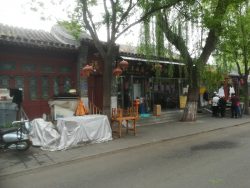
The Hutong district of Beijing
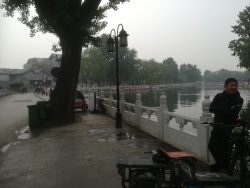
The Hutong district of Beijing
I am on my way to my childhood fantasy world of China. Having been brought up in the Baptist church I read numerous books about missionaries such as Hudson Taylor, founder of the China Inland Mission, and the equally intrepid traveler Gladys Aylward. These had both arrived in China through the port of Shanghai. I was on a nine and a half hour flight from Heathrow, London to Beijing. Hudson Taylor died over a hundred years ago in 1905 but the stories of his adventures to try and establish Christianity in this distant land still resonate in my head. By 1953 all Protestant missionaries had been expelled from communist China. Would the pictures conjured up in my head by reading their stories match the China I was to discover in 2019?
We are to to travel from Beijing to Shanghai by train and then onwards to Yichang where soon afterwards we join the Yangtze River visiting various places along the way. We disembark from our boat on the Yangtze at Chongking and then travel by train to Chengdu and Xian.
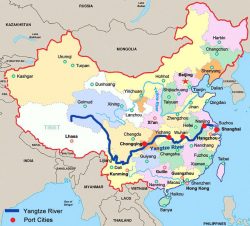
Map of China including Yangtze River
Chinese duck wrapped in a pancake
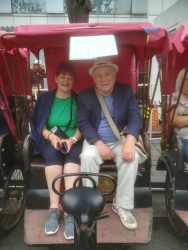
A rickshaw ride
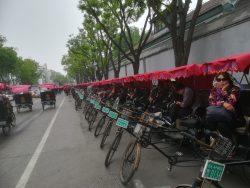
A rickshaw ride
My first experience of China is eating an evening meal of delicious duck dressed in a rich sauce and wrapped in a thin pancake. I am sitting in the restaurant of a department store in Beijing. It is not unlike a Debenhams store in the UK! In many ways it is not dissimilar to a shopping centre in Bangkok or a major city in Vietnam. The next morning we are exploring the historic area of the Hutong district of Beijing one of the few areas of the city which has not been replaced by skyscrapers and busy roadways. There is the opportunity to have a ride on a rickshaw and visit the old houses where some of the older residents still reside. However most of the younger Chinese prefer to live in a smart apartment in one of the newly built skyscrapers not least because the old toilet facilities are shared and fully public.
The Great Wall of China
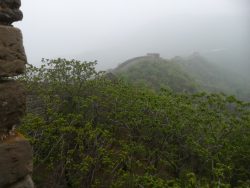
View from the Great Wall of China
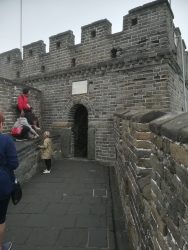
The Great Wall of China
Parts of the Great Wall of China date back to over 2,700 years ago. We are visiting the Mutianyu section of the Great Wall. Most visitors are, in fact, Chinese but many western tourists are also inevitably drawn to this iconic structure. You can walk up to the wall, take a lift on an open chair or, as I did, have a ride on a cable car. You can also come down from the wall on a toboggan run. Whatever way you choose to reach the Great Wall of China you will not be disappointed by the views from the ramparts of the wall.
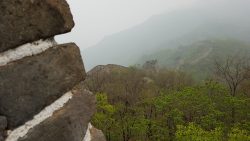
The Great Wall of China
The Wall in fact stretches over a distance of 3,968 miles. Thousands of conscripts built the Great Wall over many centuries and it must have been a dangerous and miserable existence for most of the time. How much it was a structure to repel invaders or just a vanity and status project for various Chinese leaders is difficult to know. Whatever the motivation to build the wall, it still leaves you awe struck as you view the surrounding countryside. However as I walk down the hill from the wall and stop for a cup of coffee I am surprised at the cost of the drink. The equivalent of £5.50p. Yes there are great views from the cafe but is the coffee worth this exorbitant amount?
Tiananmen Square
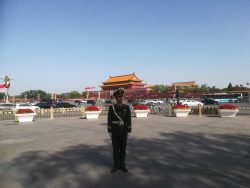
Guard on duty at Tiananmen Square
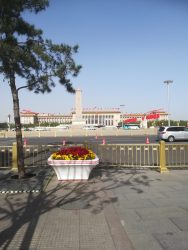
Tiananmen square
In 1989 I attended a Chinese life and culture course and learnt how to relax through Tai Chi, what happened during the rule of Mao Tse-tung and even how to speak a few words of Chinese. Some of the students on the course had recently visited Beijing and had been in the city during the student protests. The tutor on the course had been captive during the the reign of Mao and had been banished to a camp in the countryside. It is against this background that I view Tiananmen Square. Somehow it seems much smaller than the pictures previously seen on TV. It is surrounded by domestic Chinese tourists and as a western visitor you are a little bit of a celebrity as the foreign visitor is still something of a novelty. Some Chinese visitors request a photo with you to record the moment overlooking the Square.
Interestingly our guide Harry does not mention the student protests of 1989. On my return to the UK there is a constant news review of the student unrest in 1989 as part of the 30th anniversary. There is speculation about whether it was hundreds or thousands of people who died. The deaths did not happen in the Square but in the roads immediately outside Tiananmen Square. The crackdown on the unrest on 4th June 1989 still remains a point of contention between China and many Western countries.
No internet via Google
I soon discover back at my hotel it is not possible to access my emails or the internet via Google. Other folk in our party are able to access the internet using Yahoo or speak to family back in the UK via Whats App. Since coming home the row between the USA and China on the security of using Huawei has heightened but the UK has still to decide on this matter. The irony is my Huawei mobile phone will not function in terms of accessing the internet in China. So I will have a two week internet free zone whilst on holiday in China. In some ways it turns out to be an enjoyable break from checking my phone every few minutes! When I access the internet on my return to the UK it soon becomes apparent that nothing of any importance has been happening. I am further disenchanted with news reporting as it seems to highlight people who have achieved very little in terms of helping others live a more worthwhile life whilst ignoring folk who have something worthwhile to say.
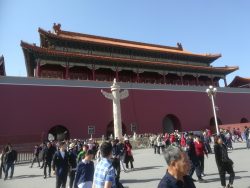
Entrance to the Forbidden City
The Forbidden City
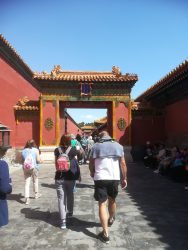
The Forbidden City
The story is told of the young boy who had become the Chinese emperor who was playing tennis in the grounds of the Forbidden City when he was told he had lost his role as emperor. He was given only ten minutes to gather his belongings and leave the Forbidden City. He was soon ridiculed by everyone in his new role as a commoner. Puyi, who was made emperor at the age of three, became the last Chinese emperor. Later on he sought help from Japan and the Soviet Union to try and reinstate himself as a ruling emperor. However he was publicly humiliated during the Cultural Revolution and died in 1967. The film ‘The Last Emperor’ captures this story and it still fascinates not only Chinese citizens but people from all over the world.
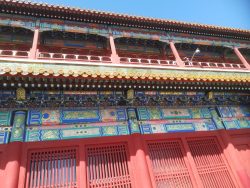
Inside the Forbidden City
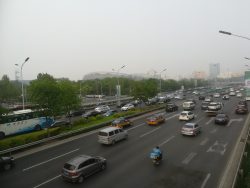
Distant view of Olympic stadium
The Forbidden city is sometimes known as the Palace Museum. Somehow the Forbidden City is a form of respite from the hustle and bustle of Beijing city. It is one of the few places where history has been retained and you can escape the skyscrapers and the constant noise and pollution of the traffic outside. Chinese authorities are attempting to reduce pollution with initiatives to stop motorists entering the city every day with a ban one day a week determined by the number plate on your car. An increasing number of public vehicles are also powered by electricity rather than diesel or petrol.
It is interesting to see how the Chinese authorities have tried to develop the use of the Olympic stadium since the 2008 Olympics. It is partly a destination for Chinese domestic tourists and a venue for foreign exhibition football matches such as Manchester City versus Arsenal.
Mao Tse-tung
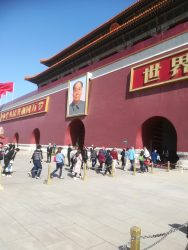
A picture of Mao Tse-tung outside the Forbidden City
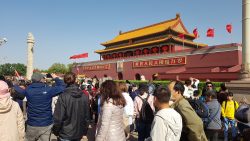
Mao Tse Tung outside the Forbidden City
Mao Tse-tung also known as Chairman Mao ruled the People’s Republic of China from its establishment in 1949 until his death in 1976. Interestingly it is allowed to criticise Mao today whilst also acknowledging his achievements in modernising Chinese society. He initiated the Cultural Revolution when anyone opposing his ideas was ruthlessly removed and it was generally perceived as a class struggle with ‘intellectuals’ being banished to the countryside. One of our local guide’s grandparents had been on the receiving end of this anti intellectual doctrine and were banished to the countryside to be farm workers.
There is the interesting story of the visit of US President Richard Nixon to Beijing in 1972. He was due to visit the Great Wall of China but the road to the Wall was completely frozen over and putting his visit into jeopardy. Mao organised over 40,000 local workers to chip away manually at the frozen road to the Wall and his visit went ahead as planned.
The bullet train from Beijing to Shanghai
It is about 750 miles from Beijing to Shanghai but the journey by train can now be completed in less than 5 hours. The view of the countryside and towns and cities along the way is quite bleak. There seems to be never ending blocks of skyscraper apartments. They almost seem to have been dropped from on high and are often situated in the middle of nowhere and without any apparent infrastructure of schools, hospitals and shops. Interestingly there are also a number of solar power panels on view apparently there to power the heating of plants grown for agricultural development.
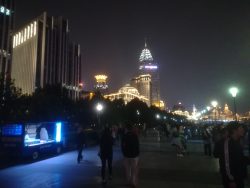
The Bund in Shanghai
Shanghai by night
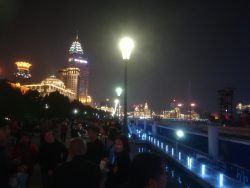
The water front in Shanghai
The Bund area of Shanghai is a sight worth seeing at night time as all the buildings by the water front are lit up and provide a glistening vista. Apparently ‘The Bund’ is an Anglo/Indian word meaning water front. A key building is called Big Ching and looks like a replica of Big Ben.
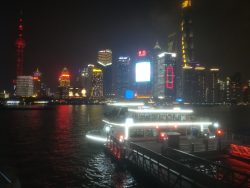
Shanghai at night
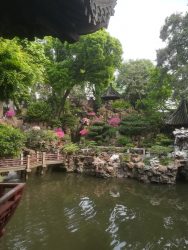
The Yu Garden, Shanghai
The Yu Garden in Shanghai
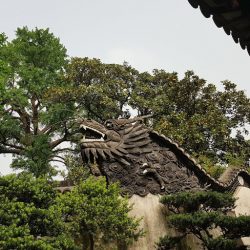
The Dragon at the Yu Garden in Shanghai
The Yu Garden in Shanghai is well worth a visit. It is a piece of tranquility in the midst of a hectic city that never seems to stop. Essentially it is a landscaped rockery with delightful fish ponds situated between the rocks. It was originally built in 1559. It reminded me of my Mum’s pond which is shaped in the form of a meandering river but sadly on my return to the UK I discover a heron had eaten the dozens of fish which used to inhabit the pond. Somehow the fish had survived over fifty years swimming around the water lilies before the water heron managed to pierce the netting protecting the fish. In an odd way it quite upset me as it was part of my family home and the heron managed to destroy these happy memories. There are apparently no big birds lurking in the ponds of the Yu Garden to threaten the life of the fish!
The high speed train to the Yangtze River
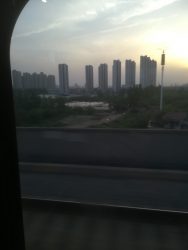
High rise apartments in Chinese countryside
Shanghai railway station is apparent chaos in action. It is May bank holiday in China and thousands of Chinese are trying to escape the city to visit family. The Chinese however do not seem to have a sense of queuing! We enter the station via escalators but none of the escalators on entering the station are moving in our direction but all the the exit escalators (in the opposite direction) are moving. So we struggle to maneuver our suitcases down the static escalators. Have we entered the station via the wrong entrance? We are about to embark on a seven and a half hour train journey to Maoping on the Yangtze river. This time the countryside flying by on the outside of the railway carriage is a little more inviting although we pass through a number of major cities with their high rise apartments. We pass by cities such as Yichang which have a population of four million people. It is difficult to grasp the massive population of China which today is over 1.4 billion people.
An early morning start with Tai Chi
The boat journey on the Yangtze River is the part of my holiday I have most been looking forward to. Your response may be more interesting than the Great Wall of China, the Terracotta Warriors or the Panda Reserve? Well in a strange way yes. There is something magical about travelling along one of the major rivers in the world and viewing the country it passes through from the vantage point of a boat. Previously I have travelled up the Mekong River for 2 days passing between the two countries of Thailand and Laos and loved every minute of it. I start my first morning on the boat at 6.30am with a Tai Chi lesson. There is only me and a Chinese family of 3 plus the instructor. It is good fun and also a spiritual experience as you slowly allow your body to move into positions it is not accustomed to.
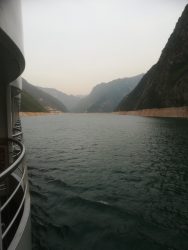
View from the boat on the Yangtze River
The Yangtze River
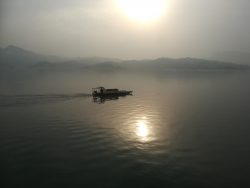
The banks of the River Yangtze
The Yangtze river is the third longest river in the world and the longest in China. For the next four nights and three days we are to cruise along the relative tranquil waters of the Yangtze River. Fortunately we have a balcony attached to our cabin from which we can view the other boats on the river and life on the banks of the river.
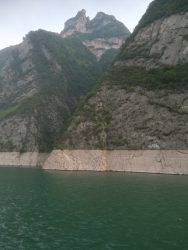
The banks of the River Yangtze
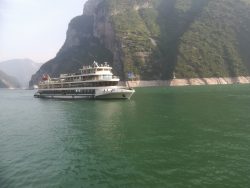
Passing boats on the Yangtze River
The Three Gorges Dam
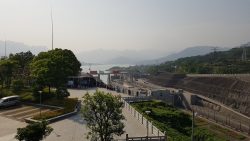
The Three Gorges Dam
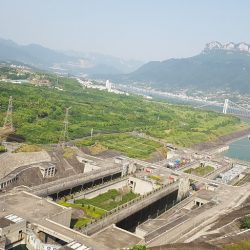
The Three Gorges Dam
The Three Gorges Dam is the world’s largest power station in terms of output and is an incredible feat of engineering. Our guide who accompanies us on the bus from the boat to the dam entertains us with a few melodies on his harmonica. He does the journey every day and has been doing this for many years but somehow he still maintains his enthusiasm. There are 40,000 visitors to the dam per day. The cost of constructing the dam was recovered in ten years including the displacement costs of moving 1.4 million people and submerging their homes under the water. The young people see the value of this project as they are now living in modern apartments and not having to live with 3 generations of their family. The old however miss their homes which are buried beneath the water.
You cannot imagine the speed of construction happening in Western Europe. In the UK there would be endless consultations and planning meetings to hear the voice of those who would be losing their homes. A good example is the proposed Hs2 rail route from London through Birmingham and dividing off towards Leeds and Manchester. Thousands of houses will probably be destroyed to make way for this new railway. So in the West we feel the protests are understandable and are expressed through a democratic process. In China this is not the case so decisions can be made much more quickly. What is happening in the UK seems much more muddled but I prefer this to the system in China. This is not to deny the engineering achievement of the Three Gorges Dam or the successful working partnerships with overseas companies such as the German company Siemens.
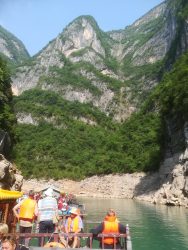
The mountains surrounding the Goddess Stream
A visit to the Goddess Stream
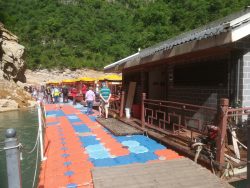
Boats (Sampans) by the side of the Goddess Stream
The Goddess Stream is situated on the south bank of the Yangtze River and opposite the Goddess Peak of Wu Gorge. It is a beautiful setting surrounded by steep mountains and hidden in a deep valley. There is also a tradition of wedging coffins of the dead in the crevices of the rocks of the gorges. The coffins are made out of stone and wood. It is home to the Tujia people a minority ethnic group numbering about 8 million with two million living in this region. Interestingly Tujian is a spoken language and it is not written down.
The Han people are the largest ethnic group in China numbering 1.2 billion people. Interestingly the ‘one child policy’ introduced by the Chinese state applied to the Han people but not to the smaller ethnic groups. So young people brought up in a Tujia family might have been brought up in families of three or more children. The ‘one child policy’ has created a situation where young men significantly outnumber young women and it is therefore much more difficult for young males to find a partner than their female equivalents. A number of female fetuses were previously aborted as males were preferred to females.
How do you find a partner?
There is a delightful local tradition of celebrating the birth of a daughter by planting a bamboo tree. The tree is cut down when the daughter is due to be married and the wood is used to make furniture which can be part of her dowry. Many Chinese go to a ‘matchmaker’ to find a suitable partner. This can for example be an elderly aunt who is a respected member of the local community. It is usually perceived to be more expensive to have a son rather than a daughter, particularly in the urban areas, as they are expected to provide a house and own a car. In the rural areas he may build his own house and in parts where the Tujia live, where there may not be any roads, build a boat.
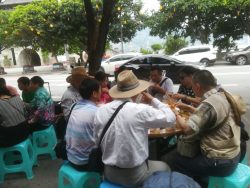
A cafe in Fengjie
Getting to know the locals in Fengjie
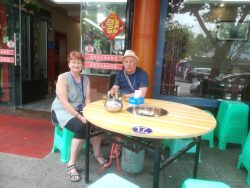
Drinking tea in Fengjie
The boat we are sailing on stops at the town of Fengjie and we have the opportunity to wander around for about two hours. Fengjie is a couple of hundred kilometers upstream from the Three Gorges Dam. It is not a tourist spot which makes it all the more interesting to visit. We develop the skill of talking to the locals via a translator on their mobile phone. We talk into the phone in English and it immediately translates into the local Chinese language. It is great fun. We drink a cup of Chinese tea and eat a few seeds.
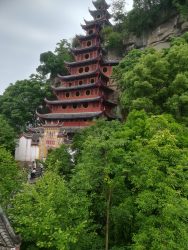
The Pagoda at Shibaozhai
A visit to Shibaozhai
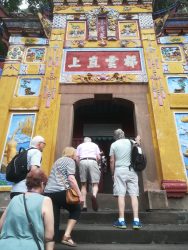
The Pagoda Temple
The Shibaozhai Pagoda is also known as the ‘Precious Stone Fortress’. It is situated on a craggy hill on the river bank of the Yangtze and the bright red pavilion dates back to the 19th century. There are 99 steps up the top of the Pagoda. So you need to be fit.
Superficially China is an atheist country but this temple is evidence of private religious practice. A number of Chinese come here every day to worship quietly. This is representative of a wider religious heritage such as Taoism, Buddhism, Christianity and in places like Xian an active Muslim community. When you are traveling through China you sense a spiritual heritage. Even Tai Chi has a spiritual quality to it as it is a form of meditation as well as a martial art. You can see all generations of Chinese practicing Tai Chi in public parks and it is a delight to watch. However religious belief is not publicly paraded as it is perceived that the Chinese state would not approve.
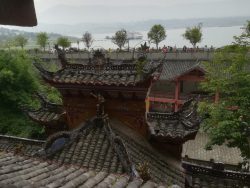
A view of the Pagoda overlooking the Yangtze
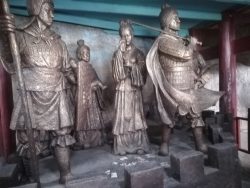
Chinese figures in the Pagoda
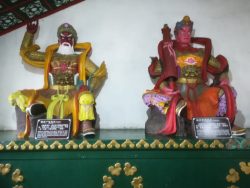
Buddhist figures in the temple
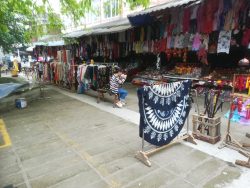
The market in Shibaozhai
Likewise Feng Shui which uses energy forces to harmonize with their surrounding environment has a type of spiritual dimension to it. There is no doubt that Chinese life does recognise the importance of linking human wellbeing with connecting with nature. An example is the wide use of Chinese herbal medicine which is not normally used in Western medical practice. The use of natural remedies is an important part of Chinese herbal medicine and is sometimes known as homeopathic medicine. Despite this I rarely heard the sound of a bird on my travels in China even on the banks of the Yangtze. Modern China, particularly in the urban areas, seems to struggle to incorporate nature into its lifestyle although this is not unique to China.
A Chinese family stop me in the market area of Shibaozhai to ask if I would have my photograph taken with their father who is probably a similar age to me. He is too shy to ask. He is wearing a straw hat similar to mine and is delighted to have the photo taken as it is a novelty to see Westerners in this town.
We disembark at Chongqing
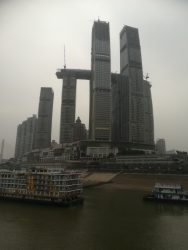
The skyscrapers of Chongqing
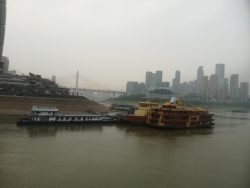
The harbour of Chongqing
If you were asked what is the biggest city in China in terms of population, how many would say Chongqing? It has a population of 33 million people. Part of the reason why it is such a high population is because the defined boundaries of the city are much broader compared with cities such as Shanghai and Beijing. Chongqing is a stopping off point on the way to Chengdu and we visit Emperor Yu’s Palace in Chongqing before we catch the train to Chengdu. Chengdu is sometimes defined as the ‘laid back city’. Perhaps part of the reason for this name is its Buddhist influence with temples such as the Wenshu Monastry in the city and the country of Burma (Myanmar) not being far away. It is famous for the earthquake in 2008 when 100,000 people were killed. There is the lovely story of a little boy being found alive in the ruins after 3 days. On seeing his western rescuer he thinks he is in the USA.
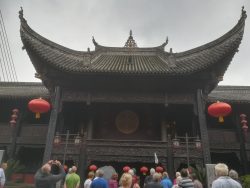
Emperor Yu’s Paiace in Chongqing
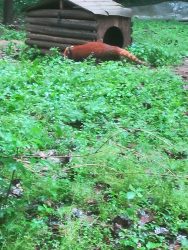
The Red Panda
A visit to the panda reserve
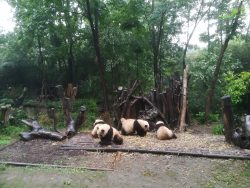
A group of Giant Pandas
The panda reserve is based outside the city of Chengdu and is spread over an area of 200 acres and is home to over a hundred of these magnificent creatures. Apparently there is a period of 72 hours each year when the Giant Panda can become pregnant. The female is very choosy when choosing a partner and only chooses a male with certain physical features. They are a very singular animal but are a delight to watch as they eat their bamboo sticks and climb the trees in the reserve. There are two sorts of pandas the red panda and the giant black and white giant panda. Click below to view
We arrive in Xian
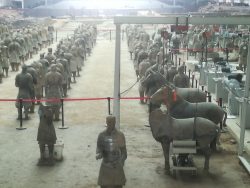
The Terracotta Warriors
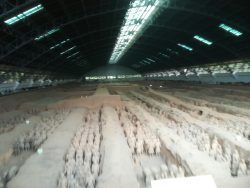
The Terracotta Warriors
We travel to Xian by train the home of the Terracotta Warriors. The Terracotta Warriors are known as the 8th Wonder of the World. The 6,000 figures were buried in 210 BC, but incredibly they were only discovered by farmers in 1974. The life sized statues were built as part of an elaborate tomb of the Qin Emperor, believed to protect him in death as his real army had in life. It is a breath-taking sight as you see all these soldiers standing in line accompanied by chariots and horses.
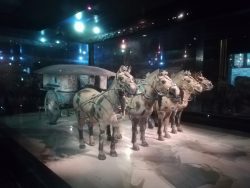
Chariot & horses at the Terracotta exhibition
A visit to the opera
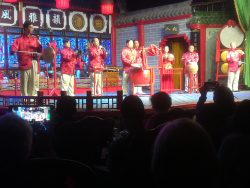
Chinese opera
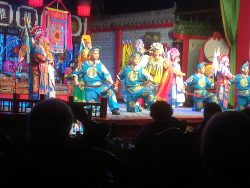
Chinese opera
The evening at the theatre is more like a Chinese version of the old music hall in England than an opera. Yes there is lots of singing but also the playing of very unusual Chinese musical instruments, ‘slap stick’ comedy, magic and the amazing changes of the face through the use of Chinese masks. What I particularly liked was the way the theatre was laid out as you were able to sit around small tables and drink tea and eat nuts as you watched the performance. Also there is the opportunity to have a head and shoulder massage before the live entertainment. All ages are represented in the audience including children, parents and grandparents. It is truly family entertainment.
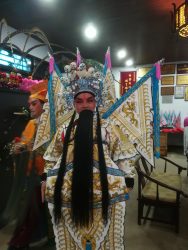
An artist in makeup before the opera
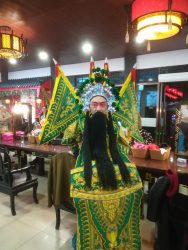
An artist in makeup before the opera
The performance also transcends language and cultural differences and the fact I did not speak Chinese did not detract from my enjoyment of the entertainment. What is particularly stunning is the magnificent costumes worn by the men and women participating in the opera. We are given the privilege to watch the artists in makeup before they perform.
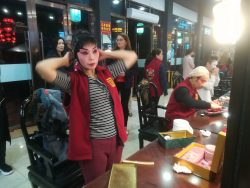
Theatre makeup behind the scenes
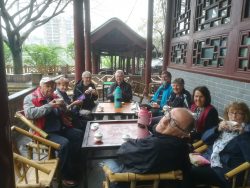
Chinese Tea Garden
A Chinese tea garden
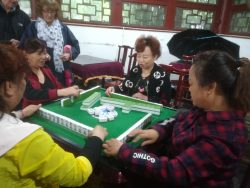
Chinese board game
One of the delights of being in China is a visit to a Chinese Tea Garden. It is a place where you can enjoy playing a board game, have a shoulder and head massage or just enjoy nature sitting on your bamboo chair. This tea garden is in Xian.
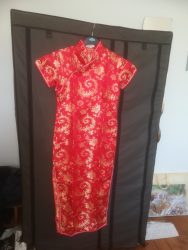
A silk dress bought in a Pagoda Garden
How do you earn a living?
One of the local guides on our tour tried to answer the question what are the main industries and ways of earning a living in China. We are taken to a silk making factory, a place where various jade products are on display and a workshop where model Terracotta models are made. However I doubt if these activities employ a significant proportion of the Chinese people. Tourism is a growth industry and construction is evidently a major employer. If you google this question then it highlights mining, manufacturing (such as chemical fertilizers, cement and steel) and power as major employers. However talking to some local people a lot of Chinese folk are employed buying and selling on the internet. There is also the question of how much of Chinese commerce is state owned and this seems to be a difficult one to unravel.
Interestingly there is a significant tax in China on luxury goods such as cars, Gucci handbags and designer shoes. One of our guides describes how when he visits the UK he buys several pairs of good quality shoes as they are so much cheaper than the equivalent product in China.
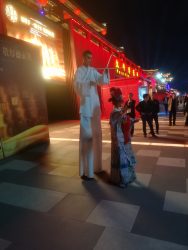
Street theatre in Xian
A lasting memory of China
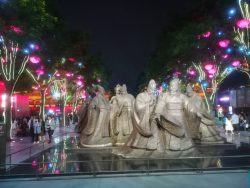
Street theatre in Xian
What are my lasting memories of China? A country with a rich heritage of culture and theatre which is still alive and celebrated today. Surprisingly it is much more urbanized than I expected with Skyscrapers not only in the major cities but also in the middle of what was recently the countryside. Many of the Chinese are benefiting from a buoyant economy and show off their new found status by driving a Western car such as Volkswagen, BMW or Audi. It also seems to have a well managed economy where most people are employed. Unlike countries like India there does not seem to be a sizable underclass although there is evidence of inequality of wealth since the state has allowed free enterprise and encouraged trade with other countries.
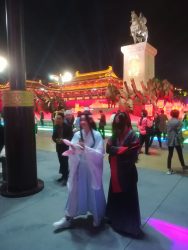
Street theatre
The warmth of welcome from the Chinese people
It is time to return home to the UK and we have a flight from Xian to Beijing and then onward to London. I will remember the warmth of welcome from the local Chinese people we met. They are curious about where you are from and what you think of their country. Most have never traveled abroad but are now taking up the opportunity to discover the major sights in China. Pictures of the iconic Terracotta Warriors, the Giant Pandas, the Great Wall of China and the beautiful scenery on the banks of the Yangtze River will stay with me for the rest of my life. If you have visited China please share your thoughts. If you live in China or are Chinese born but now live abroad please share your own observations. If you would like to stay in Airbnb in China please click here
Post Corona Virus
I an writing this, in August 2020, over a year after our visit to China. It almost seems bizarre that the whole world was subsequently in lockdown just a few months after our visit. We briefly passed through Wuhan to board our boat for the trip on the Yangtze River. Wuhan is the city where the Corona Virus first emerged and we observed pictures of a city with empty and silent streets and when the occasional person emerges they are wearing a mask. Little were we to know the same would be observed in countries throughout the world. Today the city has fully recovered and we can watch pictures of crowded swimming pool parties and no one having to wear a mask. Hopefully this will soon be the case throughout the rest of the world and international travel will again be the norm including tours of China.

